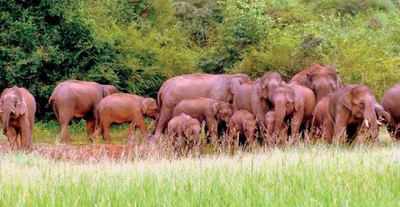Radio collaring can help jumbos, crops and Hosur farmers
Category : Wildlife |
Location : National | Posted on 2021-08-11 23:25:48

It is a double whammy: On one hand the Hosur forest division records an average of seven elephant deaths in road accidents in the past five years alone, on the other hand crop-raiding herds of elephants create tension among villagers who suffer crop losses and seek government compensation for it.
As we discuss the topic now, villagers of Veppanahalli, Navanur, Denganikottai and Javalagiri in Hosur forest division are keeping their fingers crossed, as nearly 25 elephants, including a couple of calves, are raiding the crops in these villages.
Road accident deaths of elephants and crop-raids by herds are common and little has been done to track the movement of the forest giants.
Solutions are not hard to find. Raman Sukumar, Asiatic elephant expert and former professor of Indian Institute of Science, Bengaluru, says radio-collaring the animals can help reduce incidents of crop raiding, as well as the pachyderms getting killed while trying the cross the Chennai-Bengaluru highway near Sanamavu in Hosur forest division.
The Hosur forest division and adjoining forests are home to about 300 elephants. Many of these animals regularly move into contiguous, adjoining forests of Karnataka and through a series of small forest patches northward into Chittoor forests of Andhra Pradesh. The southward movement of these elephants takes them to the Cauvery River.
Radio-collaring of elephants ranging in the northern fragmented habitats of the Hosur forest division is vital to preempt elephant occurrence in conflict regions or around high-risk areas such as highways, human habitations and crop fields, says Sukumar.
Radio-collaring had to be done to prevent any human-elephant casualties pro-actively and also to restrict their movement towards human habitation further north in the states of Andhra Pradesh and Karnataka, he said.
Collaring of elephants ranging in the more contiguous habitats closer to the Cauvery wildlife sanctuary in the southern Hosur forest division would help in understanding habitat use and decision-making about this elephant population and to develop movement and habitat use models for the entire population.
The average herd size recorded in this region is around 10 and, at times, they range in group-size as large as 70, especially during the cropping season. By collaring a few select adult females, one would, in fact, be able to gather fine-scale information on a large sub-set of the population.
Adult males are known to have a high tendency to move in the fragmented landscapes in this region. Those that use the small and large forest patches across fragile corridors dissected by highways are collared, thus providing information on their feeding and breeding areas. This gives an idea of the corridors that need to be secured, he said.
When asked, a wildlife official said Tamil Nadu has given its nod for radio-collaring the herd in Hosur forest division, and that it is awaiting the Union ministry of environment for clearance.
Source: https://timesofindia.indiatimes.com/city/chennai/radio-collaring-can-help-jumbos-crops-and-hosur-farmers/articleshowprint/85261364.cms
